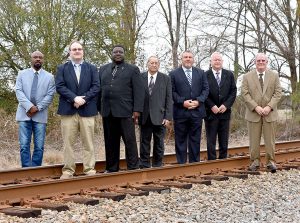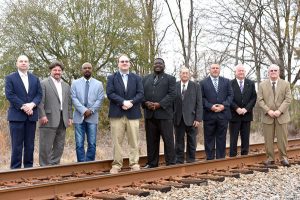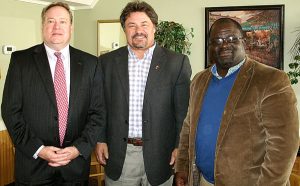By Betsy Finklea
The coming of the inland port brings a great deal of promise for potential growth in Dillon County.
At a recent meeting of the Dillon Rotary Club, Jack Ellenberg, Senior Vice-President of Strategic Projects with the South Carolina Ports Authority, gave an overview of the South Carolina Ports Authority, where they are headed, and why they are coming here.
Ellenberg introduced Michael Elmore who will be running the Dillon operation.
Ellenberg said people hear about the Ports Authority, and they think Charleston, but they don’t know who they are.
The port traces its roots to the 1600s, but became an authority in 1942. Things have changed dramatically over the years.
The Ports Authority is a major influence on the economy in South Carolina and in the Southeast. They have a $53 billion annual economic impact on South Carolina, which is about 10 percent of the state’s GDP (Gross Domestic Product). Companies who use the Ports Authority generate about $914 million in annual state tax revenue. One in 11 jobs are related to port activity, and port-related jobs pay 40 percent more than the average S.C. wage. Port activity impacts every county in the state.
They are not exclusive to South Carolina. They handle 26 states and 140 countries around the world. They are a major player in the Southeast’s economy.
They are an enterprise agency of the state, which means that they do not receive an appropriation to cover their business. They exist on their ability to produce revenue to cover their expenses.
The S.C. Ports Authority has three operations- The Port of Charleston, The Port of Georgetown, and The Inland Port in Greer. Soon, they will be adding The Inland Port-Dillon.
The Port of Charleston covers several municipalities. They have five terminals in the area including two container terminals, two breakbulk/Ro-Ro facilities (roll-on, roll-off), one cruise facility, and a container terminal under construction.
As far as the markets they serve, about 78 percent of their business in containerization, which is the bulk of their business; 16 percent is breakbulk; and six percent is cruise. “All three are equally important to us. All three are critical to our revenue stream,” said Ellenberg.
As far as Charleston is concerned, the Ports Authority is very proud that it is the fastest growing port in the country. In the last five years, their container volume has grown 43 percent, significantly faster than their competition in the same period of time. Their intermodal volume has grown 166 percent in the past five years and makes up 25 percent of their total volume.
Ellenberg said the last six months have been great. They have two new cranes at the Port of Charleston. They are 155 feet tall. They are going big because the industry is changing. They are the strongest East Coast port as far as European services are concerned and the fastest growing port as far as Asian services are concerned. Vietnam and Shanghai most recently added services. They also announced Inland Port-Dillon.
Ellenberg said there were three trends driving their business. They are:
1) “The Southeast is where the growth is and ports thrive on growth.”
2) “Ships are getting larger with consequences for port terminals and infrastructure.”
3) “Innovative thinking needed for efficient inland movement. Case in point…S.C. Inland Port.”
Ellenberg said the Southeast is the fastest growing region in the country. More people are coming to the Southeast than leaving the Southeast. The Southeast is the best U.S. port market and a great place for the ports to be.
Ellenberg said they are responding to the massive growth of ships. Vessels up to 14,000 TEU (twenty-foot equivalent unit) will be coming to the port in the spring.
Ellenberg said they have innovative inland solutions to respond. Inland Port Greer opened in 2013 and exceeded their expectations. It is highly successful. It was launched with BMW as their primary customer. They are open 24/7 because their customers operate 24/7. The cranes there are the tallest structures in Greer. It has had phenomenal growth in container volume. It will close this year with about 115,000 containers through this facility. Greer is successful because they can take a container from a vessel and have it in Greer in 24 hours. When one asks a customer why they choose Greer, some of the reasons are lower cost, lower risk, reliability and flexibility, reduced emissions by 75 percent, the ideal geographic location, and four modal potential, he stated.
Ellenberg said if you want to be a top-ten port, one has to spend “a lot of money”. In the next five years, they are going to spend $2.2 billion on infrastructure to be able to move freight. He said it was critical that they drive volume. In the next five years, they expect phase one of the Navy base terminal to be open; the Charleston Harbor to be deepened to 52 feet; and the new dual-rail served intermodal yard to be open. He said there is a great deal going on in the next five years. He said there was going to be a great deal of pressure on Charleston to deliver.
The Inland Port-Dillon project was started in September of last year. He said the board came to him and said Greer had been phenomenally successful and to find another location, preferably on the CSX line. It was code-named Project Pedro. The chosen location is on the CSX-A line, the primary thoroughfare on the CXS line north to south; it is on the I-95 corridor which is important to getting trucks in and out; and off the interstate and there is a customer base in the area-not just Harbor Freight, but companies like Domtar, Flakeboard, and International Paper. In Dillon, they have identified an initial hub of customers that would use the facility.
Ellenberg said they are currently in the design phase. Phase one will be able to handle about 45,000 containers annually and the goal is to grow it to 100,000. He said it will absolutely be successful. He said their goal moving forward is to drive volume through this terminal.
He has approached NESA, and Marlboro Electric is also participating in funding the master plan. They want to make sure they are ready to attract companies when they open. They are looking at the supporting infrastructure and what needs to be done to make the port successful and to make the community successful. They are currently aggressively marketing the facility and talking to companies every day around the world about using this facility.
Ellenberg said they were going to be part of this community, and they want this community to be successful. He said they recognize there are challenges, and they want to help influence the way this community goes. He said they take very seriously their role in this process.

Randy Goings, Robbie Coward, Archie Scott, Bobby Moody, Stevie Grice, T.F. “Buzzy” Finklea, Jr., and Harold Moody

County Attorney Alan Berry, Interim County Administrator Rodney Berry, Council members Randy Goings, Robbie Coward, Archie Scott, Bobby Moody, Stevie Grice, T.F. “Buzzy” Finklea, Jr., and Harold Moody

Jack Ellenberg, Rodney Berry, and Michael Elmore


